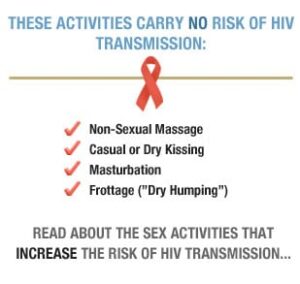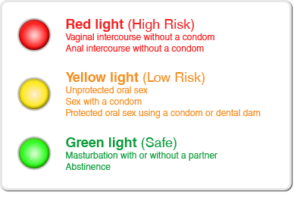Introduction – HIV and STD risks
This blog focuses on your HIV and STD risks from sexual activities other than intercourse. It is the sixth blog in an ongoing series on HIV and AIDS.
- To read a discussion of HIV being eliminated from the body, click here.
- For an explanation of what HIV and AIDS are, click here.
- For an explanation how HIV and AIDS are contracted, click here.
- To learn about signs and symptoms of HIV and AIDS, click here.
- Also, for an explanation of the risk of contracting HIV from specific acts of sexual intercourse, click here.
First of all, here are some terms you should understand.
Rimming: oral-anal contact
Fingering: digital sexual stimulation
Next, let’s review.
Performing Oral Sex On A Man
- You can get HIV by performing oral sex on your male partner. The risk is not as pronounced as it is with unprotected vaginal or anal sex, but oral sex clearly is a mode of transmitting HIV.
- You are also at risk for getting other sexually transmitted infections (STIs), including herpes, syphilis, chlamydia and gonorrhea.
- Using condoms during oral sex reduces the risk of contracting HIV and other STIs.
- You reduce the risk of contracting HIV from oral sex if your male partner does not ejaculate in your mouth.
- You reduce the risk of contracting HIV from oral sex if you do not have open sores or cuts in your mouth.
Receiving Oral Sex If You Are A Man
- The risk of contracting HIV is less with receiving oral sex than many other sexual activities, but it is still present.
- You reduce the risk of contracting HIV from receiving oral sex if you do not have open sores or cuts on your penis.
- Oral sex also presents a risk of contracting other STIs, most notably herpes.
Performing Oral Sex On A Woman
- Significant levels of HIV have been found in vaginal secretions. There is a risk of contracting HIV from this activity. Fortunately, the risk is not as great with other sexual activities.
- You can contract other STIs from performing oral sex on a woman.
- Furthermore, there are effective barriers you can use to protect yourself from contact with your partner’s vaginal fluids. You can use dental dams or non-microwaveable plastic wrap to protect against HIV and other STIs. (According to the Centers for Disease Control and Prevention, plastic wrap that can be microwaved will not protect you—viruses are small enough to pass through that type of wrap.)
Receiving Oral Sex If You Are A Woman
- The risk for contracting HIV while receiving oral sex is significantly lower than for unprotected vaginal sex, but it is still present.
- It is also possible to contract other STIs while receiving oral sex.
- There are effective barriers you can use (cut-open unlubricated condom, dental dam, or non-microwaveable plastic wrap) over your vulva to protect yourself from STIs.
Oral-Anal Contact (Rimming)
- The risk of contracting HIV by rimming is very low but comes with a high risk of transmitting hepatitis A and B, parasites, and other bacteria to the partner who is doing the rimming.
- You should use a barrier method (cut-open unlubricated condom, dental dam, or non-microwaveable plastic wrap) over the anus to protect against infection.
Digital Stimulation (Fingering)
- There is a very small risk of getting HIV from fingering your partner if you have cuts or sores on your fingers and your partner has cuts or sores in the rectum or vagina.
- The use of medical-grade gloves and water-based lubricants during fingering eliminates this risk.
If you have any additional questions, please feel free to ask questions or provide comments. I cannot more highly endorse the websites at cdc.gov and the US Department of Health and Human Services.
Follow us!
Ask your SMA expert consultant any questions you may have on this topic. Also, take the #72HoursChallenge, and join the community. Additionally, as a thank you, we’re offering you a complimentary 30-day membership at www.72hourslife.com. Just use the code #NoChaser, and yes, it’s ok if you share!
Order your copy of Dr. Sterling’s books There are 72 Hours in a Day: Using Efficiency to Better Enjoy Every Part of Your Life and The 72 Hours in a Day Workbook: The Journey to The 72 Hours Life in 72 Days at Amazon or at www.jeffreysterlingbooks.com. Another free benefit to our readers is introductory pricing with multiple orders and bundles!
Thanks for liking and following Straight, No Chaser! This public service provides a sample of http://www.SterlingMedicalAdvice.com (SMA) and 844-SMA-TALK. Likewise, please share our page with your friends on WordPress! Also like us on Facebook @ SterlingMedicalAdvice.com! Follow us on Twitter at @asksterlingmd.
















